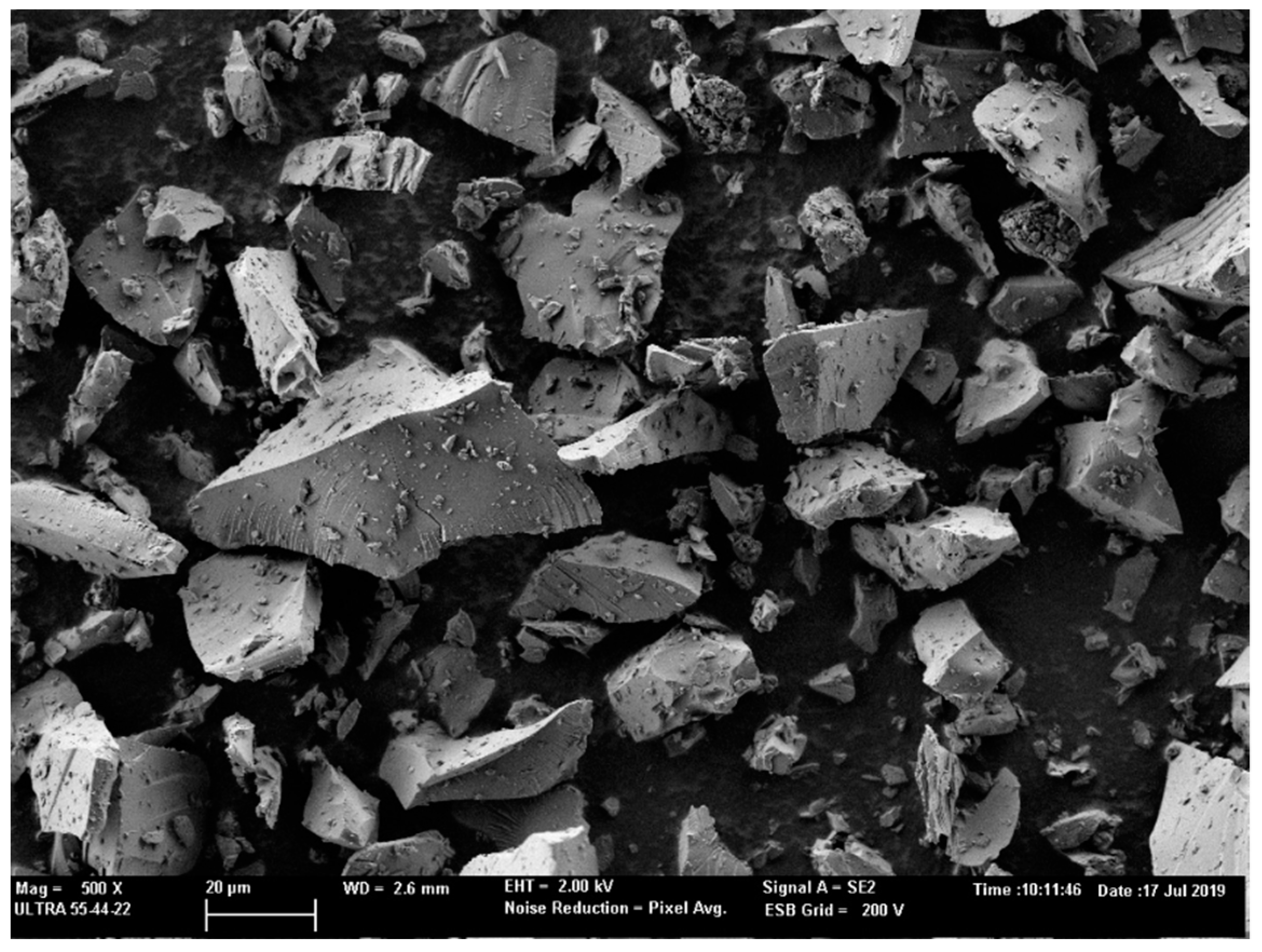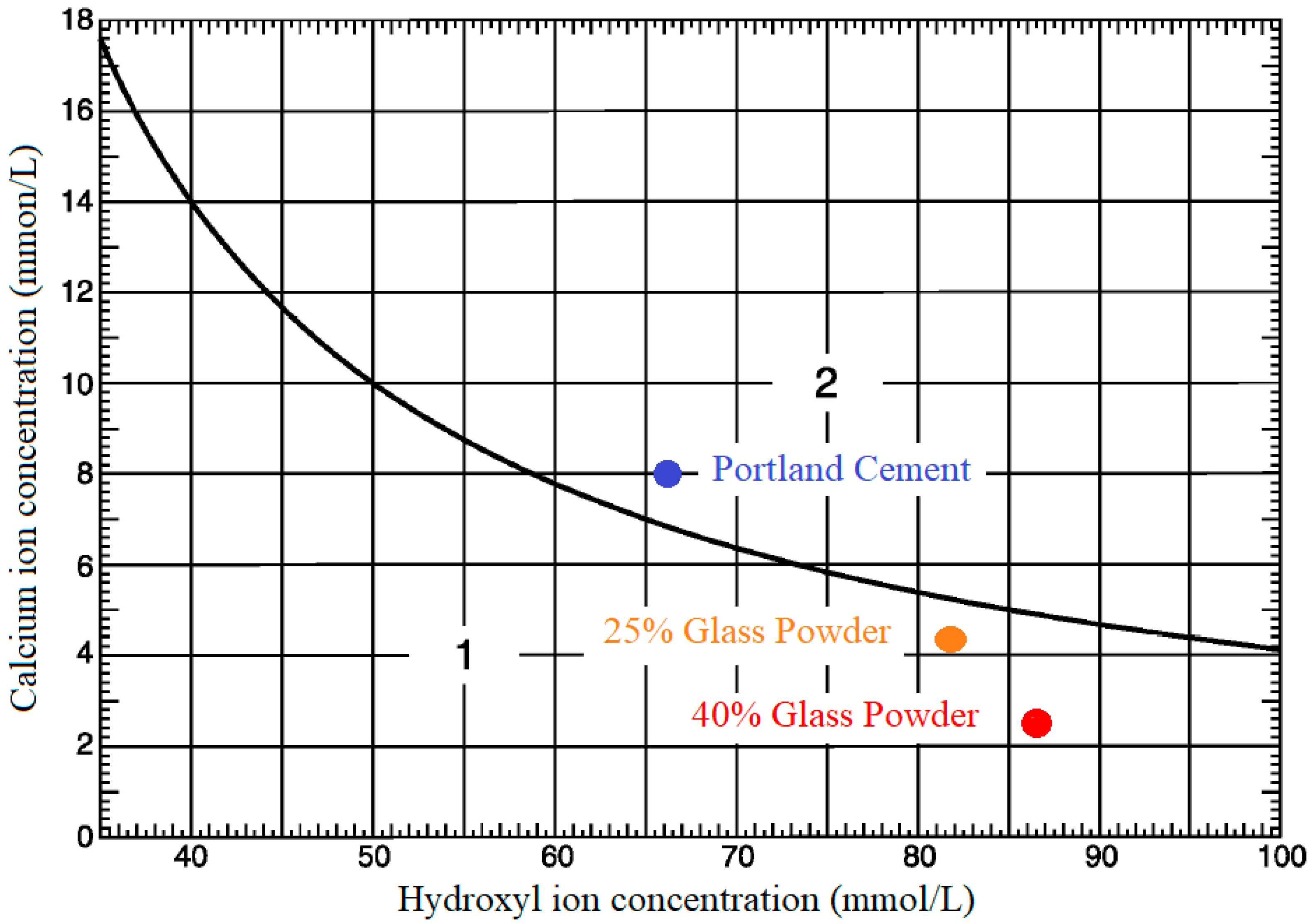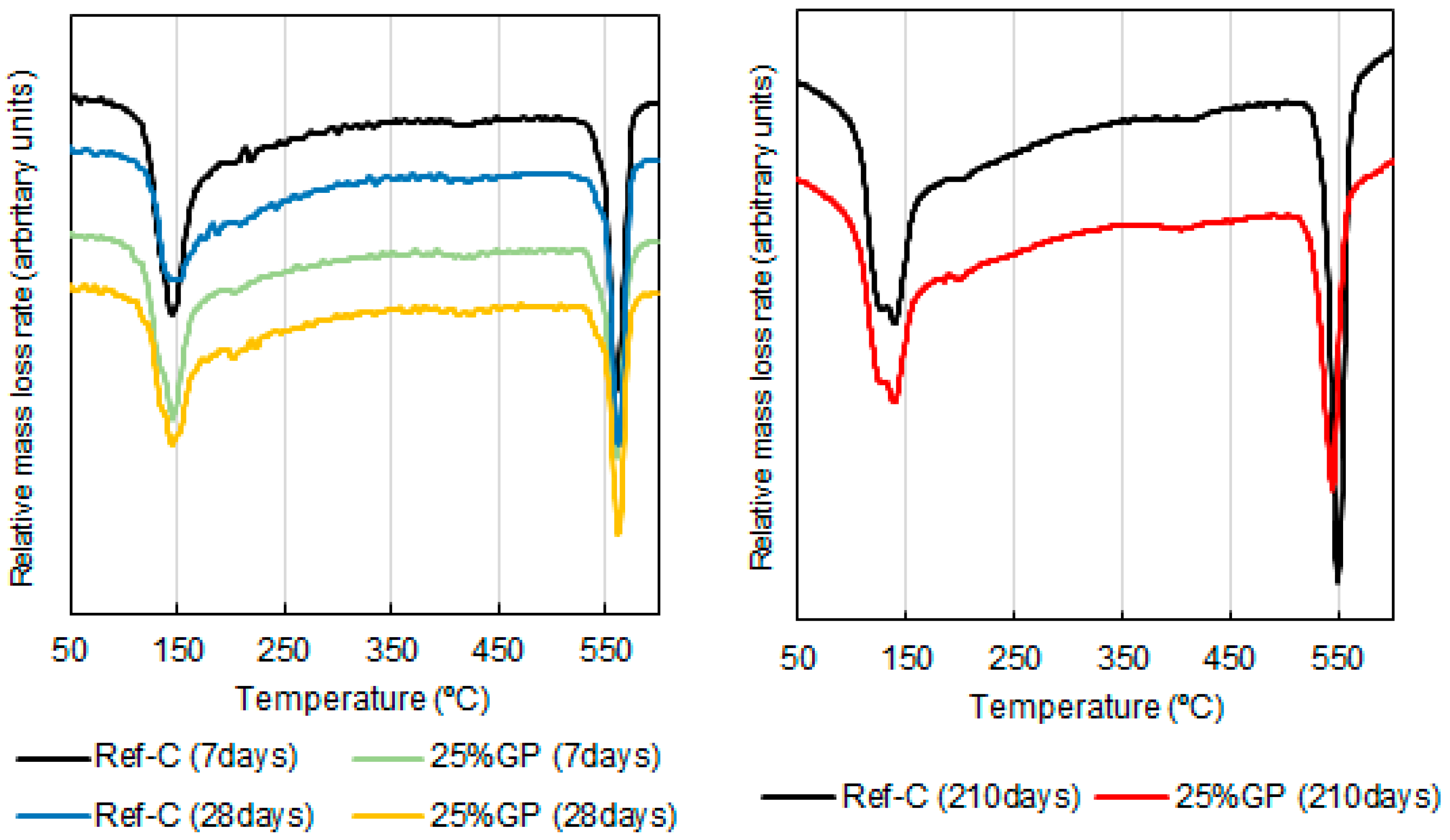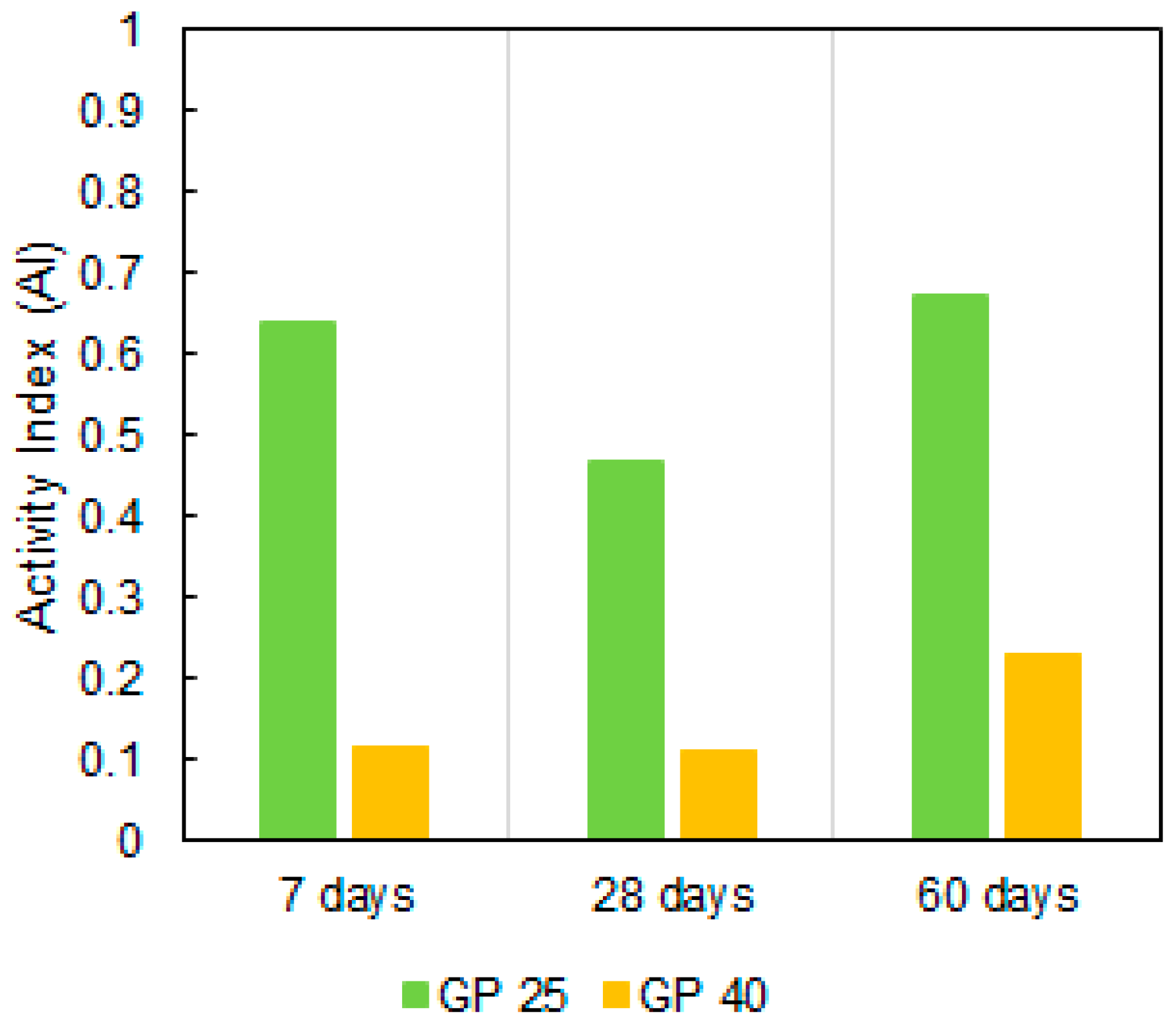Characterization of Glass Powder from Glass Recycling Process Waste and Preliminary Testing
Abstract
1. Introduction
2. Materials and Methods
2.1. Materials
2.1.1. Glass Powder
2.1.2. Other Components
2.2. GP Characterization Methods
2.3. Tests on Mortars and Concrete
2.3.1. Mortars
2.3.2. Concrete
3. Results and Discussion
3.1. Physico-Chemical Characterization
3.1.1. Pozzolanic Activity
Pozzolanic Reactivity (Fratini Test)
Thermogravimetric Analysis
3.1.2. Scanning Electronic Microscopy (SEM)
3.2. Test on Cement Mortars
3.2.1. Consistency
3.2.2. Setting Time
3.2.3. Mechanical Studies on Mortars
3.3. Testing Concrete
3.3.1. Consistency
3.3.2. Compressive Strength
4. Conclusions
Author Contributions
Funding
Institutional Review Board Statement
Informed Consent Statement
Data Availability Statement
Acknowledgments
Conflicts of Interest
References
- ANEFA Informe de Situación Económica Sectorial 2018. Available online: https://www.aridos.org/wp-content/uploads/2018/10/Informe-sectorial-Asamblea-General-ANEFA-2018.pdf (accessed on 17 February 2021).
- Meyer, C. The greening of the concrete industry. Cem. Concr. Compos. 2009, 31, 601–605. [Google Scholar] [CrossRef]
- Naik, T.R.; Moriconi, G. Environmental-friendly durable concrete made with recycled materials for sustainable concrete construction. In Proceedings of the International Symposium on Sustainable Development of Cement, Concrete and Concrete Structures, Toronto, ON, Canada, 5–7 October 2005; pp. 485–505. [Google Scholar]
- Wang, Y.; Shui, Z.; Wang, L.; Gao, X.; Huang, Y.; Song, Q.; Liu, K. Alumina-rich pozzolan modification on Portland-limestone cement concrete: Hydration kinetics, formation of hydrates and long-term performance evolution. Constr. Build. Mater. 2020, 258, 119712. [Google Scholar] [CrossRef]
- Gopalakrishnan, R.; Govindarajan, D. Compressive Strength and Electron Paramagnetic Resonance Studies on Waste Glass Admixtured Cement. New J. Glas. Ceram. 2011, 1, 119–124. [Google Scholar] [CrossRef]
- Borek, K.; Czapik, P.; Dachowski, R. Recycled glass as a substitute for quartz sand in silicate products. Materials 2020, 13, 1030. [Google Scholar] [CrossRef]
- Jiang, Y.; Ling, T.C.; Mo, K.H.; Shi, C. A critical review of waste glass powder—Multiple roles of utilization in cement-based materials and construction products. J. Environ. Manag. 2019, 242, 440–449. [Google Scholar] [CrossRef] [PubMed]
- Aliabdo, A.A.; Abd Elmoaty, A.E.M.; Aboshama, A.Y. Utilization of waste glass powder in the production of cement and concrete. Constr. Build. Mater. 2016, 124, 866–877. [Google Scholar] [CrossRef]
- Patel, D.; Tiwari, R.P.; Shrivastava, R.; Yadav, R.K. Effective utilization of waste glass powder as the substitution of cement in making paste and mortar. Constr. Build. Mater. 2019, 199, 406–415. [Google Scholar] [CrossRef]
- Wang, Y.; Cao, Y.; Zhang, P.; Ma, Y. Effective utilization of waste glass as cementitious powder and construction sand in mortar. Materials 2020, 13, 707. [Google Scholar] [CrossRef]
- Małek, M.; Łasica, W.; Jackowski, M.; Kadela, M. Effect of waste glass addition as a replacement for fine aggregate on properties of mortar. Materials 2020, 13, 3189. [Google Scholar] [CrossRef]
- Torres-Carrasco, M.; Palomo, J.G.; Puertas, F. Sodium silicate solutions from dissolution of glasswastes. Statistical analysis. Mater. Constr. 2014, 64, e014. [Google Scholar] [CrossRef]
- Torres-Carrasco, M.; Puertas, F. Waste glass in the geopolymer preparation. Mechanical and microstructural characterisation. J. Clean. Prod. 2015, 90, 397–408. [Google Scholar] [CrossRef]
- Trezza, M.A.; Rahhal, V.F. Self-activation of slag-cements with glass waste powder. Mater. Constr. 2019, 69, e203. [Google Scholar] [CrossRef]
- Shi, C.; Wu, Y.; Riefler, C.; Wang, H. Characteristics and pozzolanic reactivity of glass powders. Cem. Concr. Res. 2005, 35, 987–993. [Google Scholar] [CrossRef]
- Idir, R.; Cyr, M.; Tagnit-Hamou, A. Pozzolanic properties of fine and coarse color-mixed glass cullet. Cem. Concr. Compos. 2011, 33, 19–29. [Google Scholar] [CrossRef]
- Ecovidrio Ecovidrio. Available online: https://www.ecovidrio.es/ (accessed on 17 February 2021).
- Beerkens, R.; Santen, E. Recycling in container glass production: Present problems in European glass industry. In Collection of Papers Presented at the 66th Conference on Glass Problems; John Wiley & Sons: Hoboken, NJ, USA, 2008; pp. 181–202. [Google Scholar]
- Rashad, A.M. Recycled waste glass as fine aggregate replacement in cementitious materials based on Portland cement. Constr. Build. Mater. 2014, 72, 340–357. [Google Scholar] [CrossRef]
- Jurczak, R.; Szmatuła, F.; Rudnicki, T.; Korentz, J. Effect of ground waste glass addition on the strength and durability of low strength concrete mixes. Materials 2021, 14, 190. [Google Scholar] [CrossRef]
- Xie, Z.; Xi, Y. Use of recycled glass as a raw material in the manufacture of Portland cement. Mater. Struct. Constr. 2002, 35, 510–515. [Google Scholar] [CrossRef]
- Rahma, A.; El Naber, N.; Issa Ismail, S. Effect of glass powder on the compression strength and the workability of concrete. Cogent Eng. 2017, 4, 1373415. [Google Scholar] [CrossRef]
- Keryou, A.B.; Ibrahim, G.J. Effect of using windows waste glass as coarse aggregate on some properties of concrete. Eng. Technol. J. 2014, 32, 1519–1529. [Google Scholar]
- Afshinnia, K.; Rangaraju, P.R. Impact of combined use of ground glass powder and crushed glass aggregate on selected properties of Portland cement concrete. Constr. Build. Mater. 2016, 117, 263–272. [Google Scholar] [CrossRef]
- Zanwar, A.B.; Patil, Y.D. Utilization of waste glass powder as a cementitious material in concrete. IOP Conf. Ser. Mater. Sci. Eng. 2021, 1070, 12040. [Google Scholar] [CrossRef]
- Patel, D.; Shrivastava, R.; Tiwari, R.P.; Yadav, R.K. The role of glass powder in concrete with respect to its engineering performances using two closely different particle sizes. Struct. Concr. 2021, 22, E228–E244. [Google Scholar] [CrossRef]
- Jurczak, R.; Szmatula, F. Evaluation of the Possibility of Replacing Fly Ash with Glass Powder in Lower-Strength Concrete Mixes. Appl. Sci. 2021, 11, 396. [Google Scholar] [CrossRef]
- UNE-EN 196-5 Standard. Methods of Testing Cement. Part 5: Pozzolanicity Test for Pozzolanic Cement; Asociación Española de Normalización y Certificación (AENOR): Madrid, Spain, 2011. [Google Scholar]
- UNE-EN 196-1 Standard. Methods of Testing Cement. Part 1: Determination of Strength; Asociación Española de Normalización y Certificación (AENOR): Madrid, Spain, 2016. [Google Scholar]
- UNE-EN 1015-3 Standard. Methods of Test for Mortar for Masonry. Part 3: Determination of Consistence of Fresh Mortar (by Flow Table); Asociación Española de Normalización y Certificación (AENOR): Madrid, Spain, 2000. [Google Scholar]
- UNE-EN 196-3 Standard. Methods of Testing Cement—Part 3: Determination of Setting Times and Soundness; Asociación Española de Normalización y Certificación (AENOR): Madrid, Spain, 2016. [Google Scholar]
- UNE-EN 12350-7 Standard. Testing Fresh Concrete—Part 7: Air Content—Pressure Methods; Asociación Española de Normalización y Certificación (AENOR): Madrid, Spain, 2020. [Google Scholar]
- UNE-EN 12390-3 Standard. Testing Hardened Concrete—Part 3: Compressive Strength of Test Specimens; Asociación Española de Normalización y Certificación (AENOR): Madrid, Spain, 2020. [Google Scholar]
- UNE-EN 12390-4 Standard. Testing Hardened Concrete—Part 4: Compressive Strength—Specification for Testing Machines; Asociación Española de Normalización y Certificación (AENOR): Madrid, Spain, 2020. [Google Scholar]
- Idir, R.; Cyr, M.; Tagnit-Hamou, A. Role of the nature of reaction products in the differing behaviours of fine glass powders and coarse glass aggregates used in concrete. Mater. Struct. Constr. 2013, 46, 233–243. [Google Scholar] [CrossRef]
- Velázquez, S.; Monzó, J.; Borrachero, M.; Soriano, L.; Payá, J. Evaluation of the pozzolanic activity of spent FCC catalyst/fly ash mixtures in Portland cement pastes. Thermochim. Acta 2016, 632, 29–36. [Google Scholar] [CrossRef]
- Payá, J.; Monzó, J.; Borrachero, M.; Velázquez, S. Evaluation of the pozzolanic activity of fluid catalytic cracking catalyst residue (FC3R). Thermogravimetric analysis studies on FC3R-Portland cement pastes. Cem. Concr. Res. 2003, 33, 603–609. [Google Scholar] [CrossRef]
- Nahi, S.; Leklou, N.; Khelidj, A.; Oudjit, M.N.; Zenati, A. Properties of cement pastes and mortars containing recycled green glass powder. Constr. Build. Mater. 2020, 262, 120875. [Google Scholar] [CrossRef]
- Tamanna, N.; Tuladhar, R. Sustainable Use of Recycled Glass Powder as Cement Replacement in Concrete. Open Waste Manag. J. 2020, 13, 1–13. [Google Scholar] [CrossRef]
- Islam, G.M.M.S.; Rahman, M.H.; Kazi, N. Waste glass powder as partial replacement of cement for sustainable concrete practice. Int. J. Sustain. Built Environ. 2017, 6, 37–44. [Google Scholar] [CrossRef]
- Pu, X. Investigation on pozzolanic effect of mineral additives in cement and concrete by specific strength index. Cem. Concr. Res. 1999, 29, 951–955. [Google Scholar] [CrossRef]









| Type of Mortar | Cement (g) | Glass Powder (g) | Sand (g) | Water (g) |
|---|---|---|---|---|
| Control | 450 | 0 | 1350 | 225 |
| Cement Replacement | ||||
| GP25 | 337.50 | 112.50 | 1350 | 225 |
| GP40 | 180 | 270 | 1350 | 225 |
| Concrete Mixtures | Cement 1 | GP | Total Water | White Sand | Red Sand | Gravel 4/8 | Gravel 8/16 | Gravel 16/20 | Superplasticizer |
|---|---|---|---|---|---|---|---|---|---|
| Control | 280 | 0 | 190 | 211 | 897 | 146 | 402 | 183 | 1.4 |
| 25%GP | 210 | 70 | 190 | 211 | 897 | 146 | 402 | 183 | 1.4 |
| 40%GP | 168 | 112 | 190 | 211 | 897 | 146 | 402 | 183 | 1.4 |
| Na2O | MgO | Al2O3 | SiO2 | P2O5 | SO3 | K2O | CaO | Other | LOI 1 |
|---|---|---|---|---|---|---|---|---|---|
| 10.13 | 1.17 | 2.51 | 69.43 | 0.15 | 0.84 | 1.15 | 11.93 | 1.38 | 1.31 |
| Type of Concentration | Portland Cement | 25% Glass Powder | 40% Glass Powder |
|---|---|---|---|
| [OH] (mmol/L) | 65.45 | 82.01 | 86.05 |
| [CaO] (mmol/L) | 8.05 | 4.31 | 2.75 |
| Type of Mortar | Water Content (g) | Slump Flow (mm) | Density (kg/m3) |
|---|---|---|---|
| Control | 225 | 171.3 ± 0.7 | 2273 ± 6 |
| GP25 | 225 | 185.0 ± 0.5 | 2199 ± 12 |
| GP40 | 225 | 135.5 ± 0.6 | 2156 ± 2 |
| Paste of Standard Consistency | Composition | Setting Time | |||||
|---|---|---|---|---|---|---|---|
| Cement (g) | GP (g) | Water (g) | a/b | Initial (h) | Distance (mm) | Final (h) | |
| Control | 500 | 0 | 140 | 0.28 | 3:10 | 5 | 4:40 |
| GP-25 | 375 | 125 | 140 | 0.28 | 3:10 | 7 | 5:00 |
| GP-40 | 300 | 200 | 140 | 0.28 | 3:00 | 7 | 6:20 |
Publisher’s Note: MDPI stays neutral with regard to jurisdictional claims in published maps and institutional affiliations. |
© 2021 by the authors. Licensee MDPI, Basel, Switzerland. This article is an open access article distributed under the terms and conditions of the Creative Commons Attribution (CC BY) license (https://creativecommons.org/licenses/by/4.0/).
Share and Cite
Gimenez-Carbo, E.; Soriano, L.; Roig-Flores, M.; Serna, P. Characterization of Glass Powder from Glass Recycling Process Waste and Preliminary Testing. Materials 2021, 14, 2971. https://doi.org/10.3390/ma14112971
Gimenez-Carbo E, Soriano L, Roig-Flores M, Serna P. Characterization of Glass Powder from Glass Recycling Process Waste and Preliminary Testing. Materials. 2021; 14(11):2971. https://doi.org/10.3390/ma14112971
Chicago/Turabian StyleGimenez-Carbo, Ester, Lourdes Soriano, Marta Roig-Flores, and Pedro Serna. 2021. "Characterization of Glass Powder from Glass Recycling Process Waste and Preliminary Testing" Materials 14, no. 11: 2971. https://doi.org/10.3390/ma14112971
APA StyleGimenez-Carbo, E., Soriano, L., Roig-Flores, M., & Serna, P. (2021). Characterization of Glass Powder from Glass Recycling Process Waste and Preliminary Testing. Materials, 14(11), 2971. https://doi.org/10.3390/ma14112971







